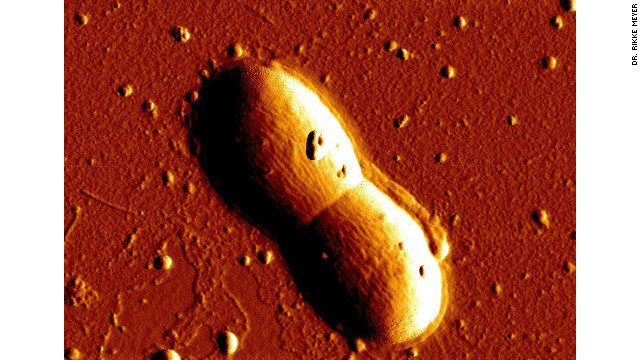This bacterial cell resembles the single-celled organisms found in 86-million-year-old sediment.
This bacterial cell resembles the single-celled organisms found in 86-million-year-old sediment.
Bacteria 'good bet' for alien life
Forget the bug-eyed green aliens with advanced technology. Life on other planets may exist in forms too tiny to see, if mysterious tiny organisms like those found under our oceans live elsewhere.
Scientists have discovered bacteria living in 86 million-year-old red clay under the ocean floor, cut off from sunlight and all other life, that may be subsisting on the minimum bit of energy required to sustain life. They use up oxygen extremely slowly, and are still recycling material that fell from the ocean's surface millions of years ago.
"If you wanted to look for life for another planet, I think this is a really good bet," said Hans Røy, biologist at Aarhus University in Aarhus, Denmark. Røy is the lead author of a new study about the bacteria that appears in the journal Science.
Røy and colleagues found the microscopic organisms about 30 meters (100 feet) below the ocean floor in the northern Pacific Ocean. Most of the genes from the bacteria don't look like anything we know on the surface.
"The paper is really fascinating, because the first time you really have a sense of the respiration rates for these buried microbial communities, you can speculate more about how long can these cut-off communities actually last, and how fast can they grow, how old can they get," says Antje Boetius of the Max Planck Institute for Marine Microbiology, who was not involved in Røy's study.
The bacteria have been sitting in 86 million-year-old sediment – mostly dead algae, small crustaceans, and dust – making the environment essentially an 86 million-year-old experiment. And you can't watch them grow – that'd be like staring at a tree waiting for it to get taller, Røy said.
"We don’t know if they’re just the remnants of those who were once at the surface and are just not dying," Røy said. "It seems like they are adapted to the environment where they live."
But it's hard to believe that the bacteria themselves are 86 million years old. Boetius estimates, given the respiration rate that Røy found, this particular group is up to 500 years old. But that's not proven, and it's still mysterious how they are getting and using such minimal energy.
There are other single-celled organisms found beneath the seafloor that appear to live for about 1,000 years before dividing. By contrast, E. coli bacteria – the pathogen found in spoiled food – reproduce about every 20 minutes.
To give you a sense of what sediment buildup means, think of the dust in your apartment or bedroom. If you never vacuumed, the dust layer would grow. If you assume a certain dust settling rate, you could calculate the time it would take to fill the entire space with dust.
"The seafloor is nothing but an accumulation of dust from the overlying seawater," says Boetius.
About 90% of the single-celled organisms on Earth live below the seafloor.
"They have no clue that we are around," Røy said of the bacteria his group studied. "They have no contacts with the surface anymore, and they just apparently keep on living for a very long time on the inside of our planet."
Similar bacteria could theoretically be buried on other celestial worlds, he said. If a planet once had life or some other energy sources, microorganisms could be cut off from the surface but still be living a long time, Boetius said.

No comments:
Post a Comment